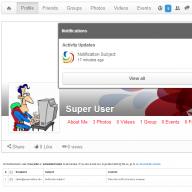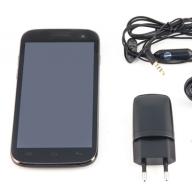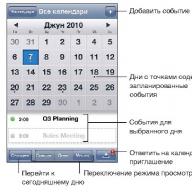Hello everyone! It's time to introduce you to a good, inexpensive charger that supports the Quick Charge 3.0 fast charging protocol. Who is too lazy to read: the device is suitable, no problems were identified during operation.
Specifications:
- Input: 100-240V 50/60Hz 0.5A Max.
- Output: 5 V=3 A, 9 V=2 A, 12 V=1.5 A.
- Fast charging support: Qualcomm QC 2.0, QC3.
- Protection: from overvoltage, short circuit, overcurrent and temperature.
- Weight: 45 gr.
Appearance
The charger is supplied in a regular spare parts package. It is immediately obvious that the device is “no-name”, because there are no characteristic inscriptions on the packaging, there is no security code or address of the manufacturer.
The charger is made of snow-white, matte plastic. There are grooves on the sides for fingers to make it easier to remove it from the socket. Made with high quality, nothing to complain about.


To connect to the power network, a Euro plug, type CEE 7/16, is used. For residents of America (and not only) the seller has an option with a type A plug.

On the side there is text information with technical characteristics.

At the top end there is a USB port with a green plastic insert. Below it is an inscription with the name of the fast charging protocol qc 3.0. The cable stays in the socket well and does not dangle. There is no light indication of operation. In general, a standard charger, which many manufacturers sell for 7-10 bucks, making their own nameplate.

Device dimensions. For comparison, I placed an 18650 battery next to it.

Disassembly
We warm the body with a hairdryer, and then carefully halve it. We take out the “internals”. The contact of the Europlug with the board is carried out thanks to metal brackets, arched type. The installation of the elements was done quite well, traces of flux are minimal. The only thing that catches your eye is the absence of radiators.

On one side of the board.
ABS 210 bridge rectifier. Used in almost all chargers that I have disassembled.

On the other side.
MOSFET transistor 4N60G.

Schottky diode MBR20100CT. Next to the USB port there is a chip labeled PT4U2K, which most likely controls the operation of Quick Charge.

Transistor optocoupler PC817B.

Testing
To begin with, as always, I checked the presence of “mind” in the charge. There is a voltage of 2.7 V on the data contacts, that is, Apple devices will be charged without problems with a current of up to 2.4 A. When connecting another smartphone, be it Samsung or LG, the voltage on D+ and D- changes, adapting to the device, providing it with maximum charge current.
Voltage without load. Everything is okay.



The device passed the QC 3.0 test, the voltage gradually rises in steps of 200 mV to 12 V, and then also smoothly decreases down to 3.7 V.

The previous Quick Charge 2.0 is also available.

Then I checked the maximum current output in various modes.
In 5V mode.
The port was able to supply 4 A without much voltage drop. Unfortunately, this is the limit for my load, but I think this is quite enough to understand that charging is not a bad idea.

In 9 V mode.
The maximum current output was 2.73 A.

In 12 V mode.
The maximum current output was 2.02 A.

Stability test.
I tested it in the modes stated by the manufacturer to make sure that the charger works normally for a long time. Test time ≈ 45 minutes.
In 5 V/3 A mode, the device heated up to 61 degrees. The voltage dropped to 4.92 V during the test.


In 9 V/2 A mode, the device heated up to 60 degrees. The voltage rose to 9.27 V.


In 12 V/1.5 A mode, the device heated up to 60 degrees. The voltage rose to 12.49 V.


Result:
A decent charger that has good assembly, declared electrical characteristics and low cost.The product was provided for writing a review by the store. The review was published in accordance with clause 18 of the Site Rules.
I'm planning to buy +22 Add to favorites I liked the review +30 +43 Banggood AliexpressPackage
The device is supplied in a box with a recognizable design with printing in pale gray tones. On the front there is a photo of the gadget, there is a Mi logo.
Also, according to tradition, on the back are technical charging parameters:

Options
There are 6 charging ports, 5 of which have a physical USB-A interface, and another one has a USB-C interface.
4 ports - have a standard voltage of 5 V, maximum total current up to 4.8 A, no more than 2.4 A per port.
Another USB - A and USB - C port support QuickCharge 3.0 technology, the maximum current at a voltage of 5V is 3A, 9V - 2A and 12V - 1.5 A.

Device dimensions - 110*80*20 mm, operating temperatures from 0 to 40 C
What is in the box
Inside the outer box is another, inner box, divided into two parts.

One contains the charging station, the other contains the power cable.

Actually, nothing more interesting is included in the kit, and nothing more is needed.

The included cable has a flat American-style plug; on the charging station side there is a standard two-pin connector, which is often found in various equipment.

Appearance, design
The panel with the connectors is sealed with a shipping sticker, a bit of a funerary appearance.

Down with the sticker, under it are the promised 6 USB ports. First USB C, then USB A with support for QC 3.0, and then 4 regular 5 Volt

The body is white and glossy, but not particularly easily soiled. The top panel shows the MI logo - but in a very light gray color.

On the lower part of the body there are 4 small legs in the corners.

At the back, in the center, there is a two-pin connector for the power cable. By the way, it is not necessary to look for an adapter for the supplied cable.

I found a free suitable cable with a Euro plug. True, it's black, but you don't need to look for adapters.

There is nothing interesting on the sides of the body. Once again I would like to note the high quality of materials and workmanship. This is the case when the thing is simply pleasant to hold in your hands.

The found cable fit like original, the connector clearly matched in size, the contact was tight and reliable.

When turned on, a white LED on the top lights up. Shooting white on white is still a challenge.

Testing
The first test is to connect my Xiaomi Mi 5X using a USB C to USB C cable, which I use to transfer data from a laptop, and the charging has started successfully.

Load tests
Standard ports - at idle they produce a voltage of 5 volts.

A load of 12.5 Watts at 2.5 A can be easily withstood without voltage drop, which is even slightly higher than the declared value. I will say that in real life, few devices consume current above 1-1.5 A when charging.
 The port supports QC 3.0 - easily produces the declared 3 A, with absolutely no voltage drop.
The port supports QC 3.0 - easily produces the declared 3 A, with absolutely no voltage drop.

Let's check the operation in QC 3.0 mode - which supports a smooth increase and decrease in voltage in steps of 0.2 V. The minimum voltage that I was able to get at the charging station is 3.76 V

It really changes in steps of 0.2 V and, upon request from the device being charged, you can get any non-standard voltage - for example 7 V, which is needed at the current stage of charging.

Maximum voltage - 12 Volts

As for the load power, the port easily delivers about 18.5 Watts - that’s more than 2 A at 9 V

Accordingly, at 12 V, the load current exceeds the value of 1.5 A. During the tests, the charging station was barely warm, which cannot be said about the electronic load, the fan of which could barely cope with the heat.

Video version of the review
Conclusion
Convenient, compact and powerful charging station from a famous brand, with support for fast charging technology. Taking up only 1 electrical outlet, it can simultaneously charge up to 6 gadgets - smartphones, tablets, power banks, or power various devices - IP cameras, universal IR bases and much more.
That's all, thanks for your attention.
Qualcomm Quick Charge is a technology from a well-known manufacturer of mobile processors that allows you to speed up charging your gadget’s battery. If you've recently purchased a new smartphone, there's a good chance that the included power supply already comes with QC and is capable of charging your phone significantly faster than any other chargers you have in your arsenal. This little piece of magic is called Quick Charge by , and it's a two-step process that promises to charge your phone quickly and, most importantly, without sacrificing battery life.
Quick Charge 2.0

Quick Charge 2.0 is one of Qualcomm's first technologies, which the company describes as a "full suite of power management technologies" for charging your device using a regular micro USB cable. For such charging to work, the company puts forward two main requirements for Quick Charge 2.0:
- smartphone or tablet with a Snapdragon processor on board
- power supply with support for Quick Charge 2.0
Because this is a two-step process, both the power supply and the phone or tablet must be licensed and certified by Qualcomm to function properly. Since almost every new smartphone that offers Quick Charge 2.0 comes with a compatible power supply, users almost always have what they need to take advantage of this technology out of the box.
Manufacturer pays for license to use QC
There are also some smartphones on sale with Snapdragon processors, where the manufacturer refused to pay for the license to use Quick Charge 2.0. A striking example of this is OnePlus and their OnePlus 3T smartphone, which uses its own fast charging Dash Charge. So be sure to check the specifications on your next device to be absolutely sure that the device supports QC.
The main part of the technology is hidden, of course, in the power supply; a smaller part falls on the processor, namely voltage and current control. Today, almost all chargers offer 10 Watts of power, or 5V/2A out of the box, which significantly speeds up the charging of most smartphones and tablets. Qualcomm's Quick Charge technology allows for multiple charging options for your device, and they come in different shapes and sizes.
The technology works as follows: it recognizes the current battery status and intelligently regulates power to your device. As a result, your phone won't charge as quickly from 70 to 100 percent as it will from 0 to 60 percent. That's why every Quick Charge update boasts the ability to quickly go from 0% to 50% charge in just 30 minutes. This is designed to regulate power and prevent high voltage and current from damaging your smartphone battery.
The biggest question surrounding this technology is the issue of battery life, in particular Does Quick Charge affect battery life? in your device. Typically, slower charging allows your battery to function for a longer time than fast charging the battery. A side effect of higher charging rates is that the case will heat up, and high temperatures almost always have a negative effect on electronics. However, there is no evidence yet to support battery degradation associated with continuous use of Qualcomm QC fast charging.
Considering that the average life of a smartphone is 1.5-2 years, during this time users will not have time to damage the smartphone’s battery with fast charging. At the very least, the wear on the battery will be the same as when using a regular “slow” charging block.

At the end of 2015, Qualcomm released updated Quick Charge 3.0 technology. It uses the same basic principles as Quick Charge 2.0, but now you'll be able to charge your phones even faster with QC 3.0.
In lab tests using a 2750 mAh battery, the Quick Charge 3.0 device charged the battery from 0% to 80% in 35 minutes, while the non-Quick Charge 3.0 device with a regular charger (5V/1A) reached only 12% charge in those same 35 minutes.
Charging speed from 0% to 80% in 35 minutes
This technology works on what Qualcomm calls Intelligent Negotiation for Optimum Voltage (INOV). This is a new computational algorithm that allows a device to determine the level of power it needs at a given time. This means that charging always operates at the most efficient and optimized rate of power transfer to the battery. Support for a wider voltage range (200mV from 3.6V to 20V) means your smartphone can dynamically adjust to one of dozens of charge levels.
Quick Charge 3.0 is implemented in the same way as previous versions, and all devices with QC 3.0 are fully backward compatible with gadgets with Quick Charge 2.0 and Quick Charge 1.0 on board. QC 3.0 supports USB Type-A, USB Type-C and micro USB. Manufacturers can easily use QC 3.0 for a wide range of chargers, not only classic chargers, but also power banks and other equipment.
Quick Charge 4.0

First introduced with a flagship processor, QC 4.0 promises faster charging speeds than ever before. Quick Charge 4.0 has three key improvements:
- 20% faster than QC 3.0
- 30% more efficient than Quick Charge 3
- operates at approximately 5 degrees Celsius
Additional "battery saving" features will extend the life of the phone's battery, and QC 4.0 is fully compatible with USB-PD USB (USB-PD) (Power Delivery). But the last interesting feature on our list is perhaps the most important. In its latest Android compatibility document, Google strongly recommended that manufacturers ditch non-standard USB-C chargers like Quick Charge and stick with the USB-PD specification. With QC 4.0, not only can you extend your phone's battery life to up to five hours with just five minutes of charging, but you won't have to worry about compatibility between the charging brick and your smartphone.
QC 4.0 hardly heats up the case
QC 4.0 also includes the latest iteration of Qualcomm's power management algorithm, Intelligent Negotiation for Optimum Voltage (INOV). This add-on is responsible for real-time temperature management, it will adjust the temperature while power is applied to ensure safe and efficient operation. The first devices with Quick Charge 4.0 on board are Xiaomi Mi6 and Samsung Galaxy S8 (version with SD 835 chip). More smartphones with QC 4.0 support will appear in the third quarter of 2017.
Recently, support for Quick Charge 3.0 has often been found in the characteristics of mobile devices - find out why this technology is useful.
In modern conditions, when social networks, Internet access and mobile devices in general play an increasingly important role in personal life and at work, it is difficult to do without a smartphone or tablet, even for a few hours. The desire of users to always stay connected and less dependent on a power outlet has prompted mobile manufacturers to use more powerful batteries and, therefore, fast charging functions to charge these batteries as quickly as possible.
How does fast charging work?
Fast charging is based on the use of higher voltage. However, both the current and voltage must be compatible with both the mobile device and the charger. Otherwise, the speed will remain the same, but there may be a risk of overheating. We discussed the issue of using non-native power supplies in more detail in.
What is Quick Charge 3.0?
Last fall, the American manufacturer Qualcomm presented Quick Charge 3.0 technology, which is currently supported by proprietary chipsets Snapdragon 821, 820, 620, 618, 617 and 430. Compared to the very first version of Quick Charge 1.0, charging speed has increased by 40%, which is four times faster than normal mode. However, the difference in speed with its predecessor, Quick Charge 2.0, is not so great. So what is special about the third generation?

Advantages
An innovative step was the introduction of the INOV (Intelligent Negotiation for Optimum Voltage, or “Smart Determination of Optimum Voltage”) function. The new technology allows you to determine and dynamically adjust the optimal power output directly to a given device and stage of the power process. Moreover, the choice of supported voltage indicators has increased - now it is available from 3.2 to 20 V with a minimum change step of 200 mV.
Due to this optimization, the coefficient of wasteful energy expenditure is reduced. This, in turn, not only makes charging more efficient, but also prevents the battery from overheating. This means that the battery in your mobile gadget will last much longer. According to the manufacturer, Quick Charge 3.0 is 38% more energy efficient than the second version of this technology.
In addition, Quick Charge 3.0 includes support for fast charging via universal, which more and more smartphone manufacturers are switching to.
Conclusion
Thus, the main feature of Quick Charge 3.0 was not so much the charging speed, but the “ability” to save energy. Currently, all flagship smartphones based on the Snapdragon 820/821 processor, and some mid-price devices, are equipped with fast charging support.
Even if you are often near a power outlet, a smartphone that runs out at the wrong time can create many inconvenient moments. What to do if it’s time to go out and the battery hasn’t had time to charge? Or when we forgot to charge our gadgets in the evening, and in the morning they greet us with warning signs of discharge? Of course, you can always use an external battery, but you also need to charge it. And it usually takes so long to charge...
Manufacturers of batteries and gadgets are well aware of this problem - and successfully solve it with the help of “fast” charging technologies. Let's take a quick look at modern fast charging technologies, especially as they continue to evolve rapidly in 2017. At MWC 2017, Meizu presented the fourth generation of its fast charging technology – Super mCharge.
Super mCharge
Super mCharge technology allows you to fully charge a smartphone with a 3000 mAh battery in just 20 minutes. How fast is it? Equipped with this technology, the Meizu prototype was 11 times faster than the iPhone 7 Plus in charging speed and was 3.6 times faster than the Samsung Galaxy S7 Edge. Of course, in 5 minutes you can charge the gadget by 30%!
To achieve this result, the high voltage direct charge (HVDC) method is used. The Super mCharge power adapter produces a voltage of 11V at a current of 5A. This means that the maximum transmitted power reaches an impressive 55 W. A regular charging cable cannot transmit such power - so to use Super mCharge you will need not only a smartphone and an adapter that supports this technology, but also a separate high-power cable.
A separate plus is that the heating temperature of the battery case during such “turbo charging”, according to Meizu promises, will not exceed 39°, which will allow you to comfortably work with the smartphone, even while charging from the mains.
Quick Charge

For several years now, Qualcomm has been releasing chips that are compatible with its own Quick Charge fast charging technology. Its support is provided either by using a separate chip in the system or a compatible Snapdragon chip. For this reason, Quick Charge technology is supported not only by Android smartphones with a Snapdragon chip, but also by individual external batteries, in particular models from Xiaomi.
In 2018, the fourth generation of Quick Charge 4.0 appeared, compatible with the USB Power Delivery (USB-PD) protocol via the USB Type-C port. But previous versions of Quick Charge do not lose their relevance - they can reduce battery charging time by up to 75%. Due to the popularity of Snapdragon chips, support for this technology can be found in many flagships from various brands. Quick Charge 3.0 technology is backward compatible with previous ones - so if your gadget supports Quick Charge 2.0, a charger with version 3 will work with it.
Quick Charge adapters charge your device faster by allowing the device to accept more voltage and current. If you connect Quick Charge to an old device, nothing bad will happen, but the gadget will charge at the same rate. As with Super mCharge, fast charging requires not only support for the technology on your gadget, but also an appropriate charger. You can use a regular cable - and you can quickly charge not only your smartphone, but also an external battery!
Super Charge, Turbo Charge, Pump Express, RapidCharge, FastCharge, VOOC Flash Charging

Each manufacturer strives to implement its own fast charging option for its devices. Alas, in anticipation of the “nano” or “graphene” battery technologies promised to us by scientists (which, in theory, can be charged instantly), all current solutions are based on a single technical solution - increasing the throughput power and current strength.
As an example of an alternative solution, we can mention OPPO with its proprietary VOOC Flash Charging technology. Thanks to the eight-pin battery, each of the internal cells is charged in parallel, with a current of 4.5 amperes and a voltage of 5 volts.
Pump Express works similar to Quick Charge, but only with MTK processors, and Super Charge from Huawei boasts high-speed charging records (but only in its flagship devices).
Instead of conclusions
When choosing fast charging technologies, ask which ones your gadget supports. And if you have an iPhone or your smartphone does not support any of them, it doesn’t matter, just choose a suitable external battery that supports fast charging, supplement it with the necessary network adapter and you will definitely not be left without communication at the most inopportune moment. And if you already have an external battery, choose a charger that supports a charge current of 2.1A, so your iPhone will charge faster.
Aukey Wall Charger is a charger that will allow you to recharge the batteries of all devices in one place. 4 USB outputs will provide simultaneous charging of four devices. This charger is suitable for both home use and travel, because it has a compact size and folding design.
- Fast charging
- Built-in fuse
- Four ports
- Universal memory
- USB-C connector
- Quick Charge 3.0 fast charging technology
- 5 ports
- Powered by network
- Compact and high performance;
- LED charge indicator;
- Qualcomm Quick Charge technology
- Protection against overheating, overvoltage and short circuit
- Three USB output connectors
- Wide input voltage range
- Informative display
- Charge current: 7.2 A;
- Total power: 36 W;
- Integrated surge protector
Other




